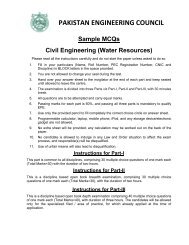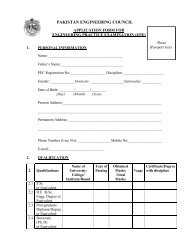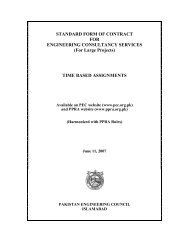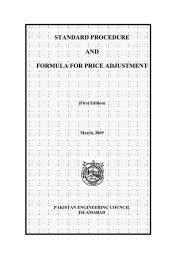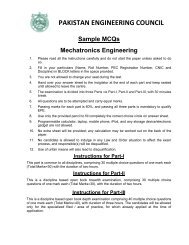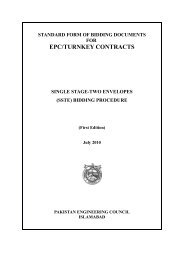Message from Chairman PEC Engr. Dr. Muhammad Akram Sheikh
Message from Chairman PEC Engr. Dr. Muhammad Akram Sheikh
Message from Chairman PEC Engr. Dr. Muhammad Akram Sheikh
You also want an ePaper? Increase the reach of your titles
YUMPU automatically turns print PDFs into web optimized ePapers that Google loves.
ENGINEER <strong>PEC</strong> September 20073. Chemical stabilization using additives.4. Dewatering systems.Dynamic motionStructural dynamic is applied to calculate stresses anddeflections. In earthquake, the loading is time varying andmaximum values are worked for structural design. Simplestructure system is represented in terms of single degreeof freedom, which ultimately leads to multiple degrees offreedom. Dynamic equilibrium is derived <strong>from</strong> staticequations that the applied force is equal to stiffnessresistance and resultant displacement. In case of dynamicequilibrium, a time varying force (force multiplied by time)and its mathematical solution derives formula forcalculating the design parameters. Time dependent forceon a simple structure (single storey) the assumptions aremade: -1. Mass at roof level2. Roof system is rigid3. Axial deformation of column neglected.19inelastic range. The location of all components, which arelikely to be damaged, should not affect gravity loadcapacity of the structure. All other components remain inthe elastic range. The design force level depends on thefirst yield level of structure when deviations start <strong>from</strong> theplastic response. Modification factors prescribed furtherreduce the design force level. Seismic design of structuralsteel system covers moment resisting frames, simplebraced frames and eccentrically braced frames. Theductility of steel reduces yield strength and therefore, itslimits lower than 50 Ksi is prescribed in the code forstructural components during the design earthquake. Theother components are expected to yield during the strongearthquake.The first system consists of moment resisting frames ofsteel columns and beams are bolted, riveted or welded atjoints. This system is most ductile and is preferred forearthquake areas. Beam to column connection and panelzone carries paramount importance. All connectionsshould be strong, stiff (rigid) and having post-yielddeformation capacity without loss of strength. Reinforcedconnections having cover plates, welded flange plates,triangular haunches, strait haunches and vertical plate ribsare used. A beam-to-column panel zone flexiblecomponent of steel moment resisting frame is to becatered for local stresses generated and strengthenedaccording to design procedures. The second systemconsists of simple braced frames, which provide lateralstrength and stiffness against earthquake forces and wind.The philosophy of bracing is that the failure occurs only inbraces, leaving the columns / beam connectionundamaged; thus structure survives earthquake withoutlosing gravity-load resistance. Beams and column inbraced frames must be designed to remain elastic when allbraces reach maximum tension or compression capacity.The third system consists of a mixture of moment resistantframe and braced frames having benefits of ductilityderived <strong>from</strong> first system and energy dissipation <strong>from</strong> thebraced frames. The loads in the braces are transferred tocolumn or another brace through shear and bending insegment of beam. This small beam (link) is designed todissipate the earthquake-induced energy. All othercomponents of system are designed to remain elasticduring the earthquake.The base motion is product of mass and groundacceleration. The earthquake forces are classified intoharmonic and impulse types. The harmonic loadingconsists of train of sinusoidal waves having givenamplitude, while impulse loading are of short duration,having impulses of different shapes. The seismic designforces are calculated by two procedures: The equivalentstatic force procedure and dynamic analysis. The staticforce procedures are based on empirical formulas and arecommonly used for regular structures having uniformdistribution of mass and stiffness. For irregular structures,dynamic analysis is used. Under the code regularstructures are up to 240 feet height and irregular structuresare 65 feet or less. Above these heights, for poor soilpressures and earthquake greater than 0.7 secondsperiod, the dynamic analysis is required. The design baseshear is directly proportional to the seismic importancefactor, soil condition factor at site and seismic dead loadand inversely proportional to fundamental period of thestructure and ductility / strength factor. The design shearsis not to exceed or decrease the limits under the code. TheSeismic zone factor (peak-ground acceleration) has to bescaled <strong>from</strong> seismic zone map and range <strong>from</strong> 0.075 to0.4. The importance factor is for margin of safety, Reinforced Concrete Structuresespecially hospitals and fire-brigade station buildings andrange <strong>from</strong> 1 to 1.25. The building period is directlyproportioned to a fixed factor depending on steel orconcrete frame (range .02 to .035) and height of building.Structural system coefficient depends on ductility andstrength of system.Steel Structures:The ductility of steel makes it ideal for seismic design. Ithas strength and toughness but what is more important iswelding and riveting. Structural members are designed asfuses and detailed to dissipate earthquake energy in theReinforced concrete is widely used in construction industryand experience shows of last few decades that buildingsare designed after finding out expected demandsmatching with capacity in earthquake areas.The ground motion and structural parameters are workedout and consist of structural fundamental period, yieldlevels, and force displacement characteristics. Thedemands have been worked out <strong>from</strong> shaking tests andperformance of structure to actual destructive earthquake.The structural engineer, apart <strong>from</strong> normal design has totake a great care of ductility or inelastic deformation



